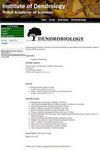保加利亚中北部两个柳无性系品种的适应潜力和生产力
IF 1.8
4区 农林科学
Q2 FORESTRY
引用次数: 1
摘要
viminalis L.柳是一种广泛种植的柳树,已被广泛用于育种目的,特别是在选择用于生物质生产的无性系和杂交种方面。本研究旨在探索和比较两个篮柳(Salix viminalis L.)无性系品种红柳和紫柳在特定土壤和气候条件下的生长和适应性,以及在保加利亚中北部一个试验种植园中的栽培实践。研究了间距、基因型、根龄和轮作对其生产力的影响,并提出了非破坏性估算木本植物生物量的异速关系。试验种植园于2018年春季建立,为Nelder轮地块的4个部分,有15个近似正方形的间距,范围从0.25到9.80平方米(每公顷40000到1020株植物)。两个品种排列在4个四辐区(每个克隆2个区)。数据收集于2018年至2020年进行,包括1年和2年的轮换。研究表明,红柳更容易干燥,导致不利的气候变化,不适应研究地点的特定条件,并在第二年和第三年逐渐消失。紫柳在不同密度、不同部门和不同年份表现出稳定的存活率(97-77%)和每年3至17毫克/公顷的生物量生产力。在生长的第一年,紫红色品种的植株重量和芽数明显高于红色品种。生长空间对枝条数量和树体数量有积极影响,在随后的轮作中,矮化使枝条数量增加了一倍,从而加强了发芽。这反映在根据旋转进行区分的残端水平异速测量模型的发展中。具有较高预测能力的树桩水平异速生长模型是基于主芽长和芽数的。还提出了与乳高芽直径的指数关系,用于分别估算每个芽的生物量。本文章由计算机程序翻译,如有差异,请以英文原文为准。
Adaptive potential and productivity of two Salix viminalis L. clonal varieties grown in North Central Bulgaria
Salix viminalis L. is a broadly cultivated willow species that has been intensively used for breeding purposes, particularly in selection of clones and hybrids for biomass production. The present study aimed to explore and compare growth and adaptability of two basket willow (Salix viminalis L.) clonal varieties - rubra and purpurea - at the specific edaphic and climate conditions and cultivation practice presented in an experimental plantation in North Central Bulgaria. The influence of spacing, genotype, root age and rotation on their productivity were also investigated and allometric relationships for non-destructive estimation of woody plant biomass were suggested. The trial plantation was established in the spring of 2018 as 4 sectors of a Nelder wheel plot with 15 nearly-square spacings, ranging from 0.25 to 9.80 m2 (40000–1020 plants per hectare). The two varieties were arranged in 4 four-spoke sectors (2 sectors per clone). Data collection took place from 2018 to 2020 and comprised 1- and 2-year rotations. The study showed that Salix viminalis var. rubra was more susceptible to desiccation-causing adverse climatic changes, poorly adapted to the specific conditions of the study site and gradually died out during the second and the third year. Salix viminalis var. purpurea exhibited steady survival rate (97 - 77%) and annual biomass productivity varying from 3 to 17 Mg/ha/year across the densities, sectors and years. During the first year of growth purpurea variety had a significantly higher plant weight and sprout number than rubra variety. Growing space affected positively the number of shoots and tree dendromass, and sprouting was reinforced by coppicing that doubled the shoot number during the subsequent rotation. This was reflected in the development of the stump-level allometric models that were differentiated according to rotation. The stump-level allometric model of higher predictive power was based on the main shoot length and shoot number. An exponential relationship to the breast-height shoot diameter was also suggested for biomass estimation of each sprout separately.
求助全文
通过发布文献求助,成功后即可免费获取论文全文。
去求助
来源期刊

Dendrobiology
农林科学-林学
CiteScore
2.20
自引率
11.10%
发文量
17
审稿时长
>12 weeks
期刊介绍:
Dendrobiology publishes original research articles and review articles related to the biology of trees and shrubs.
 求助内容:
求助内容: 应助结果提醒方式:
应助结果提醒方式:


